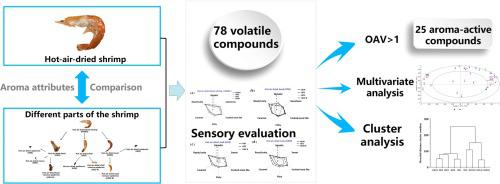Food Research International ( IF 7.0 ) Pub Date : 2020-07-09 , DOI: 10.1016/j.foodres.2020.109517 Di Zhang , Hongwu Ji , Shucheng Liu , Jing Gao

|
The objective of the study was to determine the similarities of aroma attributes in hot-air-dried whole shrimp (HDWS) and its different parts using sensory analysis and gas chromatography–mass spectrometry (GC–MS). In this study, eight samples of different parts of shrimp were compared with its whole. Characteristic volatile compounds based on odor activity value (OAV) were selected, and a cluster analysis (CA) method was used to determine the similarities of aroma profiles between the whole and parts. The potential correlations among sensory attributes and volatile compounds were analyzed by analysis of partial-least-squares regression (PLSR). A total of 78 volatile compounds were identified, and 25 volatile compounds with OAV greater than 1 were selected as the aroma-active compounds (AACs) contributing to samples’ integral aroma profile. Sixteen AACs in HDWS were identified, and four of them made important contributions, namely, 3-ethyl-2,5-dimethylpyrazine, 2,5-dimethyl pyrazide, trimethylamine, and 3-(methylthio)propionaldehyde. Fourteen AACs were the common constituents of hot-air-dried epidermis (HDE) and the whole, and their contents were quite close. CA result showed that HDWS and HDE had the highest similarity and were the first classified in a cluster. AACs summations and sensory scores of hot-air-dried head, shell, and meat decreased to various degrees after removal of shrimp epidermis, the reduction of which was more than 95% in the shell. The PLSR results showed a good correlation between most variables of sensory attributes and volatile compounds. It was concluded that shrimp epidermis made an important contribution to the aroma profile of dried shrimp and was the main source site of shrimp aroma. These results have important theoretical value for reconstructing and producing characteristic flavor substances of shrimp.
中文翻译:

使用感官分析和GC-MS分析风干虾(南美白对虾)及其不同部位的香气属性相似
该研究的目的是使用感官分析和气相色谱-质谱法(GC-MS)确定热风干燥全虾(HDWS)及其不同部位的香气属性的相似性。在这项研究中,将虾不同部位的八个样品与整个虾进行了比较。选择基于气味活性值(OAV)的特征性挥发性化合物,并使用聚类分析(CA)方法确定整体和部分之间的香气特征相似度。通过偏最小二乘回归分析(PLSR)分析了感官属性和挥发性化合物之间的潜在相关性。总共鉴定出78种挥发性化合物,并选择了OAV大于1的25种挥发性化合物作为有助于样品整体香气特征的香气活性化合物(AAC)。在HDWS中鉴定出16种AAC,其中4种做出了重要贡献,即3-乙基-2,5-二甲基吡嗪,2,5-二甲基吡嗪,三甲胺和3-(甲硫基)丙醛。14种AAC是热风干燥表皮(HDE)和整体的常见成分,其含量非常接近。CA结果表明,HDWS和HDE具有最高的相似度,并且是集群中第一个分类的类别。去除虾皮后,热风干燥的头,壳和肉的AAC总和和感官评分均有不同程度的下降,其中壳的下降超过95%。PLSR结果显示大多数感官属性变量与挥发性化合物之间具有良好的相关性。结论是,虾表皮对虾干的香气有重要作用,是虾香气的主要来源。这些结果对虾的特征风味物质的重建和生产具有重要的理论价值。











































 京公网安备 11010802027423号
京公网安备 11010802027423号